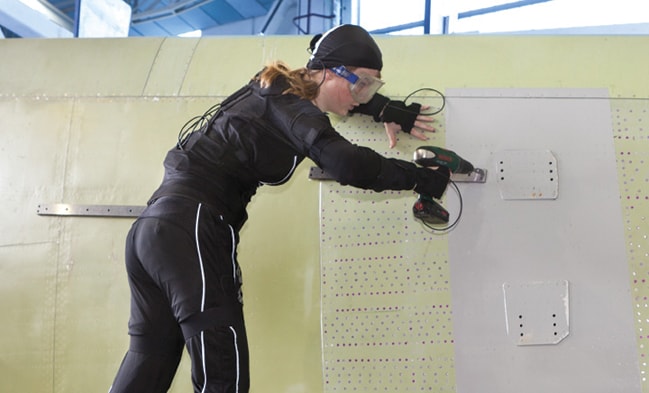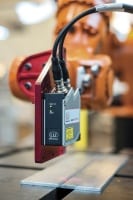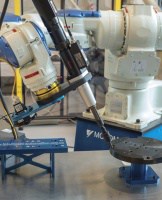Industrial robots have long been hostile, caged creatures. Around humans, their terrific power needs to be curbed; their speed needs to be restrained; and if anyone ventures into their workspace they are shut off altogether.
But in recent years, the barriers between robots and humans have been coming down. A friendlier breed of robots has begun appearing on the factory floor — and with it, the emergence of a new way of working that can cut costs and increase efficiency in labour-intensive industries.
One area that has benefited hugely is the automotive sector. “In an automotive plant, a vehicle is produced every minute, and approximately 1,000 cars are manufactured a day,” said Adolfo Suarez Roos, Airbus Group expert and robotics co-ordinator of French National Research Agency project ICARO. Turnover is high, and collaborative robots are able to help workers with repetitive tasks.
![]()
Suarez is hopeful the same success can be replicated in the aviation sector. But given that robotics isn’t as widely used, the challenges are very different. “[In automotive], a robot has 40 seconds to do its job and the complete programming task takes about a month,” he said. “At Airbus, we produce 1.5 aircraft per day, so we have to look at tasks that will last several hours. We need mobile, collaborative robots and a very simple, efficient way to programme the robot.”
“[In automotive], a robot has 40 seconds to do its job and the complete programming task takes about a month. At Airbus, we produce 1.5 aircraft per day, so we have to look at tasks that will last several hoursAdolfo Suarez Roos, Airbus Group
At Cranfield University, the EPSRC Centre in Intelligent Automation is paving the way to make this a reality in aviation. An important part of the work is understanding how tasks can be divided between industrial robots and human operators to maximise the skills of both. When man and machine are working together over long stretches of time, engineers are looking at how the human can enhance the capabilities of the robot or vice versa.
In terms of safety, the university has created a relatively simple system that uses laser scanners and 3D vision to replace physical barriers around industrial automation equipment. The team has already built a demonstration cell that is being used for the installation of movables using a human operator and an industrial robot. A laser finds the mounting points of the movable; a machine then positions it so that a worker can perform the rigging process.

“For the last 15 years, we have mainly developed motion capabilities concentrating on the robot itself,” said Christoph Borst, head of autonomy and teleoperation at the Institute of Robotics and Mechatronics, German Aerospace Center (DLR). “Now we’re starting to include the human worker and develop a language of interaction — but we need to start with simple paradigms.” Research from groups such as Cranfield and DLR is already finding its way onto the factory floor. For instance, the Airbus Puerto Real plant in Cádiz, Spain, is leading a project to expand the automation of its assembly processes with the use of collaborative humanoid robots to perform repetitive tasks.
“For the last 15 years, we have mainly developed motion capabilities concentrating on the robot itself. Now we’re starting to include the human worker and develop a language of interactionChristoph Borst, Institute of Robotics and Mechatronics, German Aerospace Center (DLR)
The project, dubbed Futurassy, last year began introducing the robots to automate the aeronautical assembly processes that could be used across other Airbus sites.
The first robotic unit acquired by Airbus arrived in Puerto Real from its manufacturer, Kawada, in Japan last year, and has been integrated at the A380 rudder spar assembly station, where riveting is now shared between human assemblers and the robot. Key to the success of this project is safety, and ensuring that the barriers between human and robot are just enough to still allow a productive working relationship.
Meanwhile in Toulouse, Airbus has been using human-integrated robotics for building the A350. Developed by RB3D, a robotic exoskeleton is used by workers to complete jobs on the production line where heavy lifting is needed.
“First we introduced safe, lightweight robots with a single arm, capable of autonomously moving around inside the aircraft to streamline the installation of brackets in the fuselage,” said Bernard Duprieu from Airbus Research and Technology. Soon, Airbus plans to install collaborative units with a higher degree of freedom, solving more complex applications in hard-to-access areas and for use at assembly stations with no change in infrastructure.

Airbus’s ‘Factory of the Future’ programme is studying the use of collaborative robots for waterproof tests on fuselages, doors and windows. This is a painstaking process that is can be tough on the human body. The robot would track the entire perimeter of the part, recording and listening for noise that would indicate a leak in the frame. Another area being explored for automation is in the manufacture of helicopter blades’ skin, which require high levels of precision.
Prof Phil Webb has been working on automation in the aerospace industry for around 20 years and is now a professor at Cranfield University. He believes legacy issues in the aviation sector make the introduction of cage-free, collaborative robots a challenge.
“The limitation is still product volume versus task complexity, which often destroys the business case,” said Webb. “This has led to the current interest in collaborative working but for most realistic applications this needs to be taken beyond the use of force/torque-limited robots and into the domain of large-scale industrial robots.

“To support this, we must also remove the existing ‘cage-based’ safety approach and look at more flexible ways of assessing, detecting, managing and preventing risk. The way in which the collaboration is managed from an employee perspective is also key to its chances of success as we are effectively breaking many existing rules in our deployment of automation.”
He claims there is no doubt that the level of automation within aerospace manufacturing will increase significantly over the next few years. Cost pressures placed on the traditional manufacturing centres in North America and Europe mean they soon won’t have a choice but to move ahead with collaborative robotics.




Glasgow trial explores AR cues for autonomous road safety
They've ploughed into a few vulnerable road users in the past. Making that less likely will make it spectacularly easy to stop the traffic for...